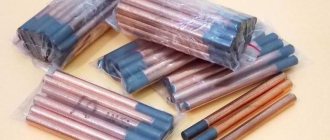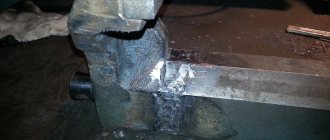Since beginners are often faced with the question of how to calcinate electrodes at home, we have prepared a step-by-step overview for you. It is important to understand that the electrode surface is a lubricant with a porous structure. If moisture gets in, it can peel off and become damp, which leads to unusability of the conductors. For the same reason, welders are faced with sticking problems, weld distortion and other difficulties.
To ensure that the electrodes remain usable, they are stored in sealed packaging. If the manufacturer does not adhere to the rules of storage and transportation, and the distributor was not at all aware of the rules for storing conductors, you are faced with damp consumables. That is why you need to understand how to dry electrodes at home in order to use them for welding. There are several types of drying. Let's consider the pros and cons of each technology, and decide on the simplest method of piercing.
Calcination of welding electrodes: what equipment will cope with the task
Even if you want to dry the electrodes at home, there is special equipment for this. Let's figure out what it is like and what its features are.
- An electric furnace with the ability to calcinate electrodes with a built-in thermostat. This is a compact equipment that is easy to transport and move from one place to another. Up to 50 kg of electrodes can be placed in a mobile electric furnace. Most often, such models are equipped with automated controls, which makes working with them easier. Standard 220 V will be enough to start the oven and dry the conductors. Models differ in power level.
- Electric oven with drying function. Modern equipment models have a microprocessor, thanks to which the process becomes automated. Thermal insulating electric furnaces provide uniform heating, which is important for complying with the rules for drying the electrode. In a conventional oven, you cannot dry the conductors precisely because it is impossible to ensure uniform temperature exposure and control the temperature. The maximum power of such electric furnaces is 8.5 kg. The conductors heat up to 400 degrees, no more is needed.
- Special case for drying electrodes. It is a sealed container that maintains a certain temperature. The thermal pencil case is easy to use due to its compact size. It differs in the specificity of heating the electrode due to the energy of the transformer. Online electrode drying is also available. The disadvantage of a thermal case is the maximum volume of electrodes – up to 10 kg. For home use, this is the optimal method of piercing.
All about welding
How to calcinate electrodes at home? This question arises for many users. The electrode coating has a porous structure; it functions like a sponge and constantly absorbs moisture. To avoid these unpleasant consequences, modern manufacturers place the electrodes in sealed plastic packaging. However, if the products are stored for too long and not used, then you will see that they have simply become damp. In order to return them to their original state, you need to know how to dry the electrodes. In the article we will tell you what calcination of electrodes is at home and what methods of drying electrodes exist.
Features of drying electrodes at home
If you decide to dry the electrodes, most likely you suspect moisture ingress. Therefore, the main purpose of drying is to reduce the percentage of moisture on the electrode surface. You don't have to be an expert to dry a conductor. Pay attention to the information written on the packaging. The manufacturer must indicate the drying conditions for the product.
If you do not have a special thermal case designed for drying the electrode, use a heating object that you have at home. For example, an electric oven will do. It must be closed. Drying the electrode over an open fire is prohibited by safety regulations.
If you ignore calcination in cases where it is absolutely necessary, this can lead to poor quality work, the creation of an incorrect seam, increased conductor consumption, and unsatisfactory results.
What is calcination of electrodes before welding?
Calcining electrodes at home is a heat treatment that allows you to get rid of moisture in their coating. Excess moisture makes it difficult to ignite the electrode and its coating begins to crumble. All this directly affects the quality of work. That is why, before welding something with an electrode, you need to carefully check them and prepare them.
Many users ask the question: what is the purpose of calcination?
It should be performed in the following situations:
- materials were stored for a long period of time,
- the electrodes were in places where there was too much humidity,
- moisture has entered the products.
- While working, you noticed that there was too much moisture on them.
Note! Calcination of electrodes before welding is the most important process, without which it is simply impossible to obtain a good result. But, you cannot perform the procedure more than twice, because... there is a high probability that the entire coating may break off from the rod.
electrode storage container
It is also necessary to calcinate the electrodes in cases where it is necessary to increase the temperature of the material consumption before work. Not all of them can be worked with without preheating, since too much temperature difference can damage the weld pool, and you will end up with a poor-quality weld.
How long, at what temperature and how are electrodes dried?
The optimal temperature is within 250, the maximum permissible is 400. Drying time takes up to 2 hours. It depends on the type of electrode and manufacturer. If the manufacturer does not indicate the requirements for the drying process on the packaging, go to its official website and clarify the parameters.
Any type of electrode can be calcined, with the exception of cellulose ones. They are not amenable to heat treatment, since when exposed to temperatures above 70 degrees, the electrode coating is destroyed. As a result, they become unsuitable for welding. These types of consumables are stored in metal cans, since they cannot be restored if they get wet.
You can dry the electrodes at high temperatures a maximum of 3 times. After this, the coating crumbles, which leads to destruction of the structure of the consumable.
If we compare the concepts of “calcination” and “drying”, the main difference is that when calcining we strictly adhere to the manufacturer’s instructions. When drying the electrode, it tries to get rid of moisture in any convenient way.
Accordingly, when drying, we can use any thermal devices. Even a hair dryer will remove unnecessary moisture. It is enough to load the electrode into the pipe and heat them at a temperature of at least 150 degrees. The diameter of the pipe is determined by the circumference of the hair dryer. There are models with a thermostat for drying that allow you to control the temperature.
Methods for drying electrodes
The electrode coating has a porous structure and works like a sponge, drawing in moisture. To avoid this, current manufacturers pack electrodes in sealed plastic packaging. But during long-term storage, the electrodes still become damp. To bring them into working condition, an oven is used to dry the electrodes. On the packaging, in addition to the main characteristics, the temperature and drying time (calcination) are indicated. It sounds something like this: the permissible moisture content of the coating before use is no more than 0.7%. If this norm is exceeded, the electrodes must be calcined at a temperature of 120-160 degrees for 1 hour.
When is drying done?
If the electrodes have been stored in a warehouse for more than 3 months, they must be dried, even if visual inspection does not reveal obvious signs of high humidity. The same applies to electrodes that have been stored for more than five days without sealed packaging. Their technical characteristics deteriorate, creating an uneven arc and improper heating of the metal, which results in a poor-quality weld. Therefore, there are clear storage rules for electrodes, as well as parameters for calcination and drying in a cabinet, oven or pencil case.
Damp electrodes lead to weld defects:
- pores form;
- fistulas may occur;
- cracks form;
- The electrode often sticks.
If the welding seam is of poor quality, or problems arise with the electrode sticking or arc ignition, then first of all it is necessary to dry the electrodes. This will not only give a high-quality seam, but also reduce the consumption of electrodes. It is not always possible to store electrodes in ideal conditions. At large construction sites or enterprises, they are purchased in large quantities and stored for quite a long time. At home, electrodes also deteriorate due to long-term storage in the garage, basement or country house.
How is drying done?
The temperature and holding time are different for different electrodes, so before you start drying, carefully study the packaging. Foreign manufacturers do not always indicate drying parameters on their boxes; to find them out, you need to go to the manufacturer’s website, where more detailed technical specifications are posted. Since cellulose electrodes must have the lowest moisture content in the coating during operation, they are packaged in metal cans and it is not recommended to calcinate this type of electrodes. In practice, they can be calcined at a temperature no higher than 70 degrees, otherwise the coating will collapse.
Special devices have been developed for this:
- bake;
- closet;
- pencil case.
In addition, there are “folk” methods - how to dry electrodes without the use of special equipment. It is recommended to carry out calcination and drying no more than 3 times. Practice has shown that with a greater number of calcinations, the coating crumbles and crumbles.
Stationary ovens for drying electrodes
In stationary conditions, an electric heating furnace is used. This is a metal cabinet with special trays for electrodes. To maintain a given temperature, all walls in it are lined with heat-insulating materials. It is equipped with a thermostat for medium temperatures ranging from 60 to 500 degrees in order to carry out drying in strict accordance with the manufacturer’s requirements. This ensures even heating and temperature retention throughout the entire process. Depending on the size and number of trays, the oven can be designed to simultaneously load batches weighing from 10 to 250 kg.
The drying process is very simple - the electrodes are placed inside the oven for the required time. The heating temperature is regulated and maintained automatically. New models have a timer that will turn off the oven after a strictly specified time. Due to thermal insulation, the cooling process occurs evenly. After this, the electrodes are ready for use.
Cases thermoses and thermal cases
It often happens that welding work is carried out outdoors or in conditions of high humidity, so the electrodes can quickly become damp and become unusable again. Pencil cases are specially designed for such cases. They are sealed and thermally insulated, allowing the electrodes to remain dry for a long time. According to their design, thermos and thermal pencil cases are distinguished.
Thermos cases are small in size and have a heat-insulating inner coating. They are especially convenient for storing already dried electrodes at construction sites in any weather and time. The electrode drying case is equipped with heating elements, a thermostat and allows drying right on the spot. It is small in size and can dry about 10 kilograms of electrodes at a time. Thermal canisters have two types of connection - to a socket and to a welding transformer.
Drying equipment makes it possible to obtain different temperature conditions and precise time control, allowing you to calcinate electrodes of various brands and manufacturers. It restores the working properties of the electrodes, speeds up the work of the welder and saves money on the purchase of new electrodes. Drying the electrodes is much faster and easier than redoing a poor-quality weld later.
How to dry electrodes at home
The main purpose of calcination is to reduce the percentage of moisture in the coating of welding electrodes, while the structure does not change in any way. To dry the electrodes you do not need any special skills or knowledge. Just look at the packaging for the temperature and time of the process. On average, it is recommended to carry out the procedure at a temperature of 220 - 250 degrees for 1.5 - 2 hours.
To do this, you can use any heating device that you have at home. An electric oven or gas oven is perfect. An electric oven is more suitable for drying than a gas oven, since the gas contains a certain amount of water and in no case should it be heated over an open fire. The quality of this method cannot be compared with the result using a professional cabinet or pencil case.
In this situation, the worst decision would be not to calcinate the electrodes at all. This will lead to increased consumption of materials, poor-quality seams, and loss of time, and in the worst case scenario, redoing the entire job.
Calcination of electrodes
furnace for calcining electrodes
The most popular and in demand are Uoni 13/55 electrodes. As an example, we will consider the technology of their calcination. Calcination of welding electrodes Uoni 13 55 must be carried out before their use. This way you can ensure stable combustion of the welding arc and high quality of the seam formed. The temperature at which the procedure is performed should be 250-300°C, time – 1 hour. It is best to calcinate the electrodes in a special oven, placing them in special boxes.
Summarizing all of the above, it is clear that drying electrodes for welding is not a complicated procedure, but it is mandatory. It is best to use a furnace for calcining electrodes. Knowing how to dry electrodes at home will make welding work much easier.










